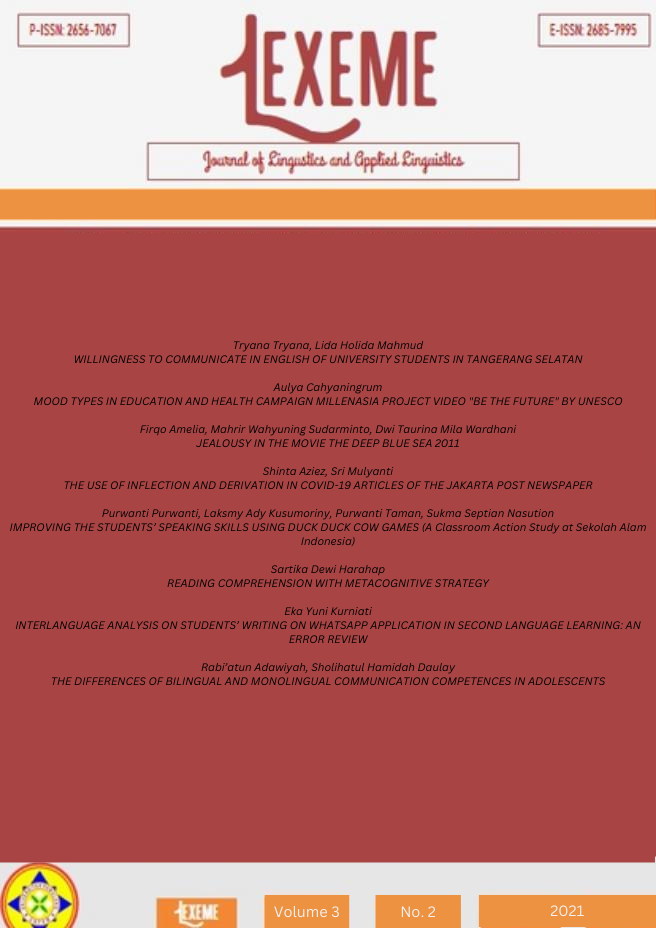THE USE OF INFLECTION AND DERIVATION IN COVID-19 ARTICLES OF THE JAKARTA POST NEWSPAPER
DOI:
https://doi.org/10.32493/ljlal.v3i2.18356Keywords:
covid-19, derivation, inflection, morpheme, newspaper, the jakarta postAbstract
English is rich with derivational and inflectional morphemes which can be seen in its articles. The goal of this study was to find out and to identify the use of derivational and inflectional morphemes in The Jakarta Post newspaper. Therefore, a descriptive qualitative method was applied in this study. In collecting the data, document and note-taking method were used. The data were selected from articles in The Jakarta Post newspaper which concerned with Covid-19 issues and were released between October 26 and 28, 2020, the year where the Covid-19 had just spread out in Indonesia, and around August 25 to 26, 2021 where the world had invented the vaccine. This study discovered that the articles had derivational morphemes formed in several prefixes; un-, en-, dis-, some suffixes; -er, -or, -ly, -y, -ion, -ment, -al, -ship, -ize, -ance, -ness, -ee, -ist, -ent, -ity, -ive, the combination of prefix and suffix; em- and -ment, un- and -able, mis- and -ion, un- and -ate, double suffixes; -or and -y, -ive and -ity, and double prefixes; un- and -dis-. It was also revealed that there were some inflectional morphemes found. They were affixes -s and -es for plural forms, -ing for progressive form, -ed for past tense form, -en for past participle, -‘s for possessive form, -est for superlative form, and -s for third person singular form. However, the affix -er for comparative form was not found in selected articles in The Jakarta Post newspaper. The findings also showed that a single free morpheme can have one to three bound morphemes in it. Inflectional morphemes can be attached to a derivational morpheme and more than one derivational morpheme can be joined to a single free morpheme. However, it did not happen in the case of inflectional morphemes, as there is no free morpheme attached by multiple inflectional morphemes.
References
Bauer, L. (1988). Introducing linguistic morphology. Edinburg: Edinburg University Press
Creswell, J. W. (2014). Research Design, Qualitatives, Quantitative, and Mixed Methods approches. Fourth edition. USA: Sage Publications.
Crystal, David. (2008). A Dictionary of Linguistics and Phonetics. Australia: Blackwell Publishing
Dixson, R. M. W. (1982). Where have all the adjective gone? And other essays in semantics and syntax. Berlin: Motion
Fitria, T. N. (2020). An analysis of derivational and inflectional morpheme in selected news from Tempo.co. Journal of Literature, Linguistics and Cultural Studies Vol. 9 (2), 146-156.
Fromkin, V., Robert, R., & Hyams. (2011). An introduction to language. Ninth Edition. Wadsworth, Canada: Cengage Learning.
Fromkin, V. & Rodman, R. (1998). An introduction to language. Sixth Edition. USA: Harcourt Brace College Publisher
Lieber, R. (2004). Morphology and lexical semantics. New York: Cambridge University Press.
Lyons, J. (1981). Language and linguistics: an introduction. Cambridge, England: Cambridge University
McCarthy, A. C. (2002). An introduction to English morphology: words and their structure. Edinburg: Edinburg University Press Ltd.
Purwanti, Y. (2020). An analysis on the use of derivational and inflectional morphemes in english song lyrics on maher zain’s “forgive me†album. Channing: English. Language Education and Literature Vol. 5 No. 2, 57-62.
Siregar, F. R., & Siregar, N. S. (2021). An Analysis of Derivational Affixes in Song. English Journal for Teaching and Learning Vol. 09 No. 01, 47-62.
Wijana, I Dewa Putu. (2021). Berkenalan dengan linguistic. Yogyakarta: TS Publisher
Yule, George. (2014). The study of language. Fifth Edition. USA: Cambridge University Press
Yule, G. (2010). The study of language. 4th edition. USA: Cambridge University Press.







